Time rules all projects, which is why time estimation is one of the most important activities there are in project management. It’s paramount to everyone involved, from stakeholders to team members. The clock is always ticking. The best a project manager can do is develop an accurate time estimate for how long it’ll take to satisfactorily complete the project.
What Is Time Estimation In Project Management?
Time estimation is a process by which an accurate forecast for the duration of the project is predicted. While this isn’t an exact science, it’s more than a guess. Time estimation involves the use of various project planning tools and techniques to determine the length of tasks and, thereby, the project.
Project management software helps estimate the duration of a project. ProjectManager is award-winning project management software that has powerful Gantt charts that can organize tasks, resources and costs to determine the length of a project. Once a schedule has been laid out in the Gantt chart, project managers can filter for the critical path to identify the essential tasks that must be completed and even set a baseline to capture the plan and compare it to your actual progress to ensure you’re staying on track.
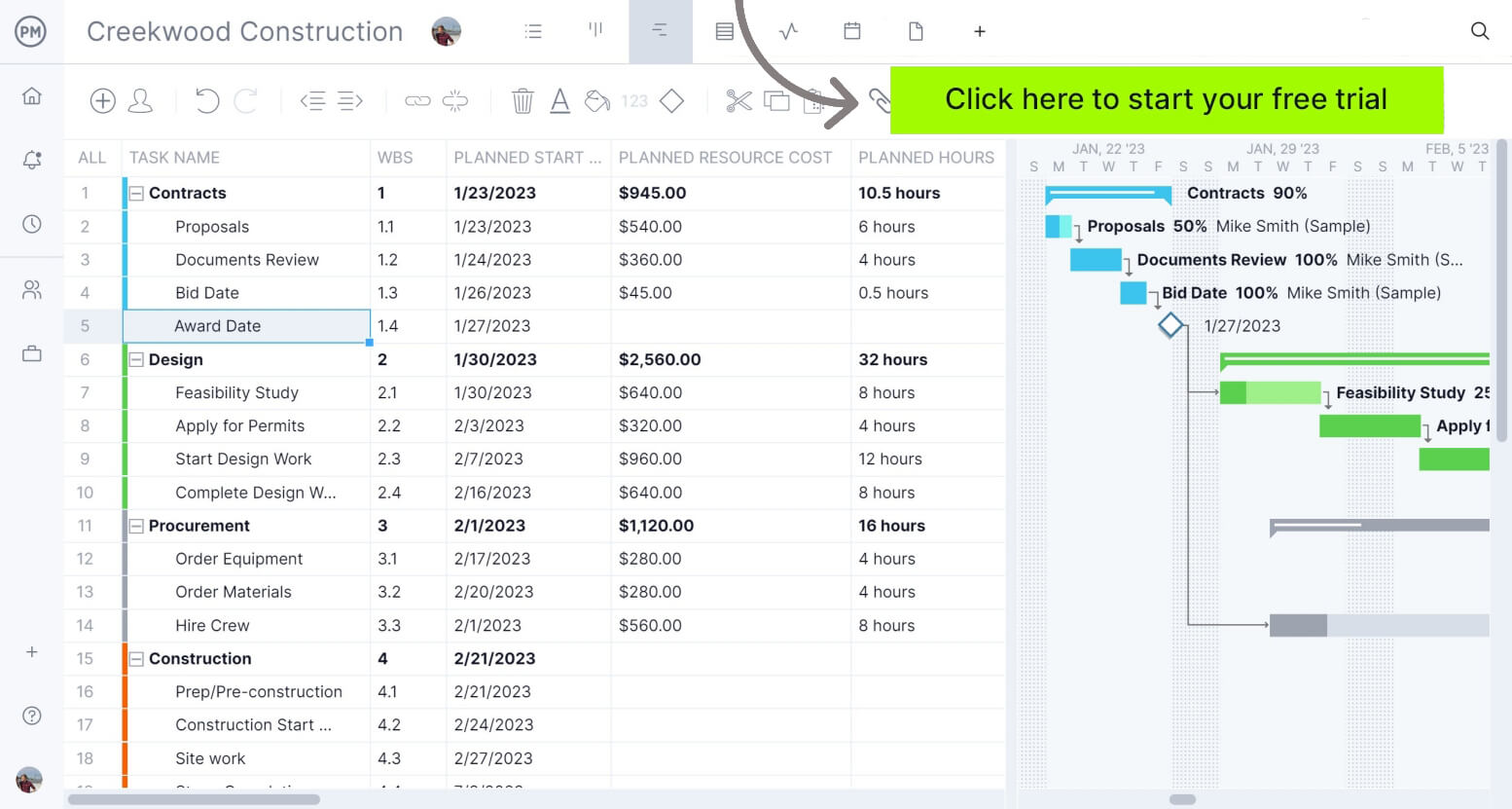
Why Is Time Estimation Important?
A 2018 study by the Project Management Institute (PMI) stated that poor time estimating is the root cause of 25 percent of failed projects. With those odds, whoever can figure out how to stop the clock will be a super project manager.
While it might be impossible to stop time, it’s possible to overcome its impending approach as it relates to the project’s end. Looking into the future to determine how much time it’ll take to complete project tasks allows for an estimation. But it’s not magic, it’s well-executed project planning techniques.
So, what are some of those tips and techniques for better project time estimation? They run from simple to complex. We’ve listed some of the tried and true time estimation methods below. See which works best with your style of project management.
5 Time Estimation Methods for Project Management
As noted, time estimation is more than guessing. It uses various methods that help with accurate estimation. Some of those methods are listed below.
1. Critical Path Method
The critical path is the longest group of tasks that have to be done for the project to be deemed successful. Therefore, the critical path method will help make your time estimate for the project duration more accurate by estimating the time each task takes to complete. You also identify those tasks that must be completed and therefore get closer attention. Some tasks are not critical and therefore can be delayed or even ignored without jeopardizing the project.
The critical path method is vital when creating realistic project schedules and identifying task dependencies as well as resource constraints and risks in the project. The calculation is difficult and takes time away from the project when done by hand, but as noted above ProjectManager can simply filter for the critical path on our Gantt chart project view. That saves time that can be devoted to more important tasks.
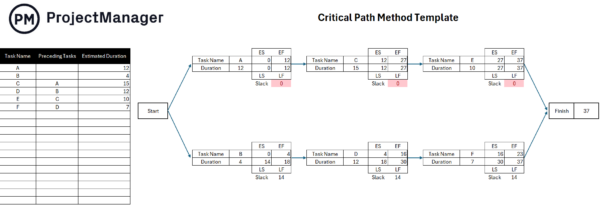
Some critical path method concepts include the earliest start time (ES) for a task, the latest start time (LS), earliest finish time (EF), latest finish time (LF) and float, which is also called slack and is how long a task can be delayed before impacting the project’s estimated time of completion. To calculate the forward pass in the critical path method, EF = ES + t (t being the activity duration). To calculate the backward pass in the critical path method, use LS = LF – t.
2. PERT
PERT (Program Evaluation and Review Technique) comes from the U.S. Navy, where it was used to estimate the time it’d take to develop ballistic missiles. What PERT does is sequence project tasks in the order in which they must be completed, estimate the duration of each and find the critical path to estimate the duration of a project. Here’s what a PERT chart looks like.
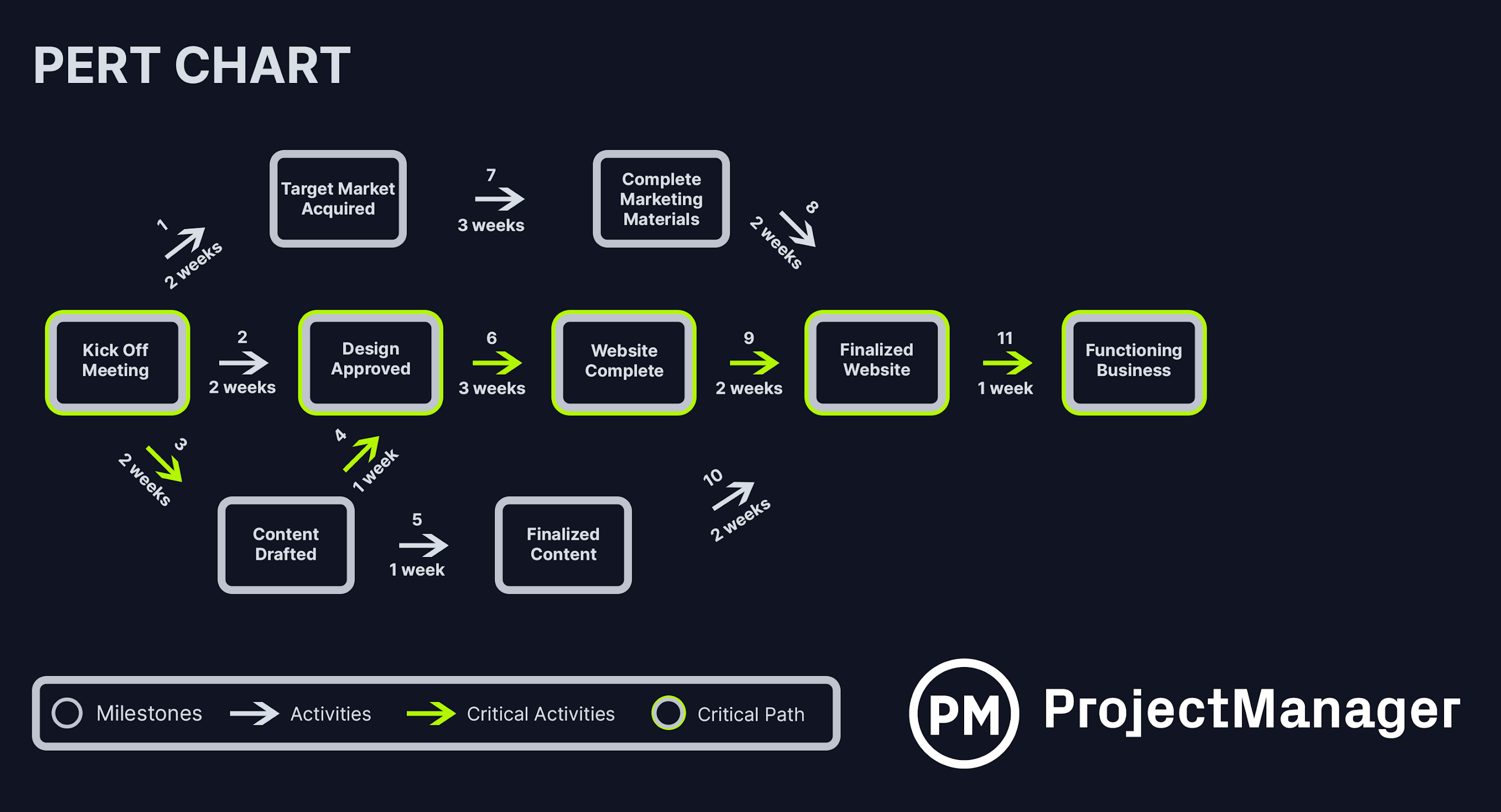
It starts with a WBS, breaking down tasks into smaller activities, which are then placed in a PERT chart or a Gantt chart. When comparing PERT Charts to Gantt Charts, on a Gantt chart, any dependent tasks—tasks that can’t start until another is finished—are linked. Each task is a line on the Gantt chart, starting at one point and ending at the completion.
3. Bottom-Up and Top-Down Estimating
Bottom-up estimating is breaking down large tasks into smaller, more detailed tasks. Then you estimate how much time it will take to complete each task. Estimating time at a granular level also increases accuracy.
Top-down estimating is an analysis in which you first develop an overview of the expected project timeline. Then using past projects, experience and historic data as a guide, determine what the time estimate is.
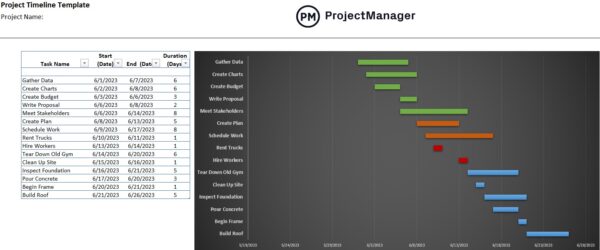
Both time estimate techniques work well together. Compare the results from both, and you’ll have an even more accurate estimation of the time needed to complete the project. If the two don’t align, it doesn’t mean one or the other is wrong, just that you must refine your estimate.
4. Historical Data Analysis
Look back at past examples and see how long they took. More than just anecdotal, historical data is information on past events and circumstances related to a certain subject. Analysis of this data is informative.
Historical data is also broad. It’s a wide net around whatever subject to which it’s related. There can be a range of information here, from press releases to financial reports, log files and project documentation.
To have a consistent time estimate, historical data is important, but it’s not cheap. Gathering historical data costs money, time and effort. But even a small amount of historical data is better than none, in that it points to precedent and can lead to planning on a path that’s more accurate in terms of estimating the time it will take the project to complete.
5. Subject Matter Expert Time Estimation
You can do much estimating on your own, and even seek historical data to place your project in a larger context, but time estimating should not be done in isolation. Speaking to a person who has worked on similar projects will uncover nuance and details not found in dry data.
Experts are great, but there might be people close by, untapped. We’re speaking about your colleagues. Teams are assembled for expertise and experience. Talk to them, brainstorm and listen to their ideas and concerns.
Chances are team members have done similar projects and have resolved issues that might have sidetracked them in the past. They can give you thoughts about efficient and effective planning, including a better sense of how long everything will take.
How to Make a Time Estimate for a Project
Follow these six steps to get an accurate estimate of the duration of your project.
1. Identify All Your Project Tasks
Use a work breakdown structure to identify all project deliverables and in turn, every task that will be required to complete to deliver a successful project.
2. Estimate the Duration of Each Task
From your list of project tasks, estimate the duration of each. These can then be added together for an estimate of the total project duration.
3. Identify Task Dependencies
Task dependencies are tasks that can’t start or finish until another has started or finished. Knowing that these dependent tasks are coming will help avoid having them be a surprise and create costly delays to the project.
4. Sequence Your Tasks
Each of the tasks you’ve identified will have to be prioritized and organized from start to finish. Some will be dependent on others and will have to be done earlier than others. At this point, sequence all tasks. This is the start of your project schedule.
5. Find the Critical Path of Your Project
We’ve explained what the critical path is and how important it is to determine the duration of the project by showing you the essential and nonessential tasks in your project.
6. Create a Project Schedule
Now, you can make a proper project schedule. You have the tasks, dependencies and sequence. Add the resources that will be required to execute those tasks and the team members who will be assigned to the tasks.
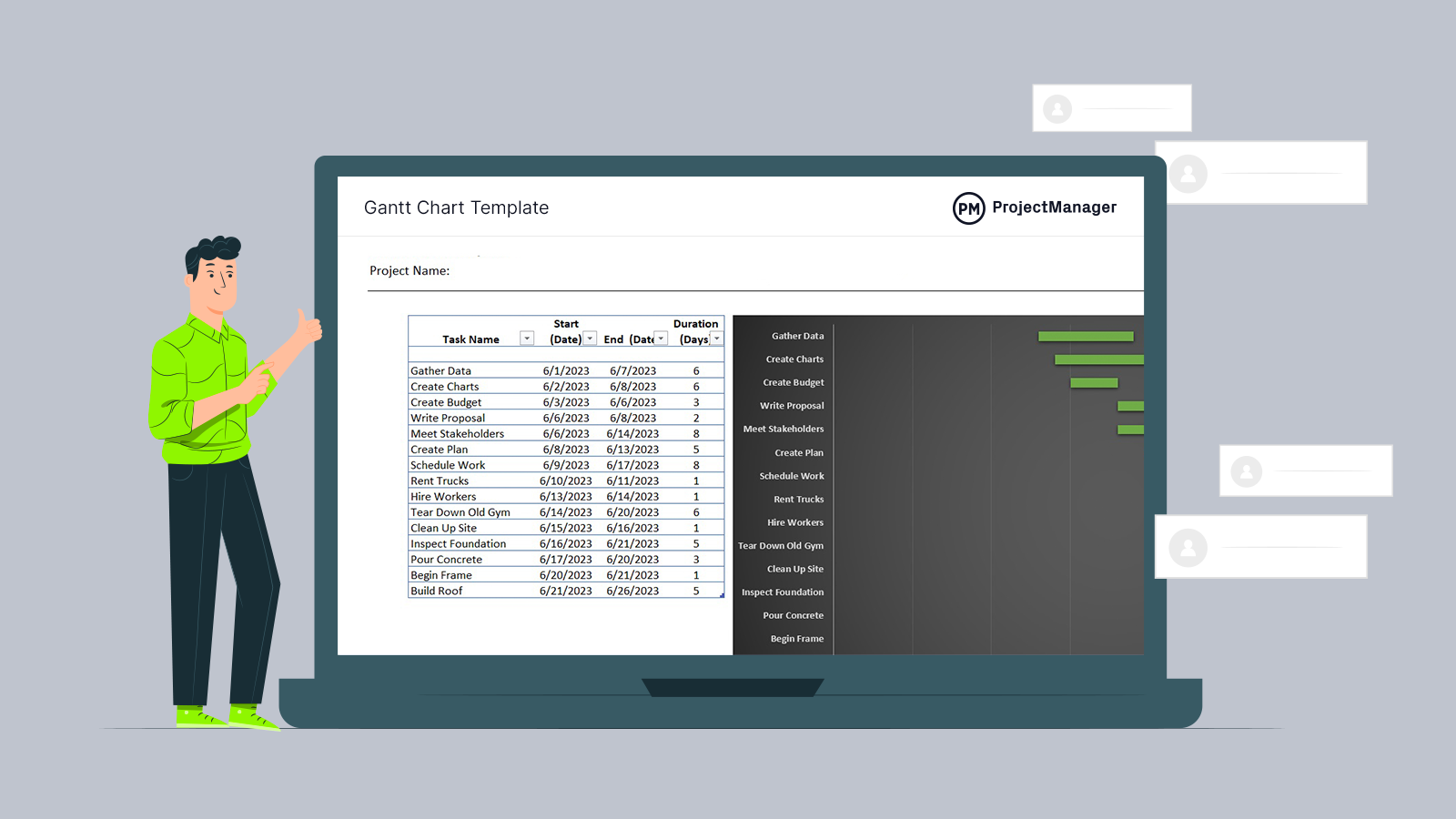
Get your free
Gantt Chart Template
Use this free Gantt Chart Template for Excel to manage your projects better.
Tips for Effective Project Time Estimation
As you’ve probably already figured out, time estimation is somewhat of an art. It’s more than a guess but less than a science. However, there are things you can do for greater accuracy with estimating the time in your project. Here are some tips.
Don’t Fall for the Planning Fallacy
The planning fallacy refers to a psychological tendency for people to underestimate the amount of time it will take to complete a task. People often neglect to take historical data into their calculations and think only of what must be done, which makes inaccurate time estimates.
Estimation mishaps are usually caused by two factors: historical data (failing to look back at how long a task had taken in the past) and making an assumption there will be no roadblocks to complicate the path forward. The latter is defined by another psychological term, optimism bias.
Know What Needs to Get Done
There are many tools that can help with identifying the tasks necessary to complete the project successfully and a more accurate schedule can emerge. Just one of those tools is a work breakdown structure (WBS), which is a way to take project deliverables and break them down into small tasks. This not only makes the work more manageable; it helps with time estimations.
Track Time Thoroughly
But a project isn’t only executing tasks. Other, seemingly insignificant, activities eat up time. Don’t forget to include the time it will take to conduct meetings, both with the team and reporting to stakeholders. There are also communications in general, testing and other activities that occur throughout the project phases.
Using ProjectManager for Time Estimation
For increased accuracy when uploading initial data, use the online Gantt chart from ProjectManager. Linking dependent tasks is easy. Editing task duration is as simple as dragging and dropping the timeline. You can even automatically calculate the critical path.
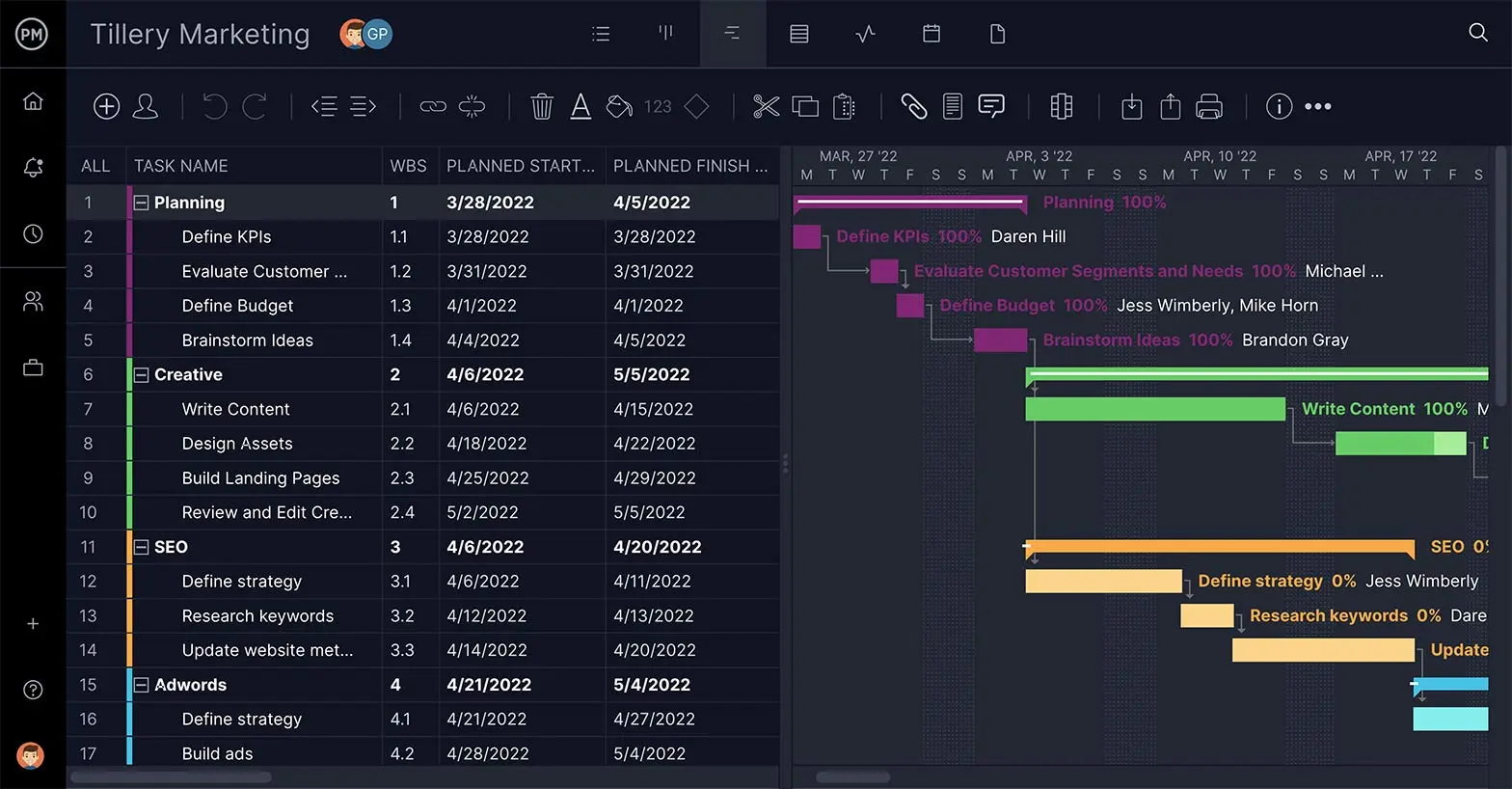
Once you have an estimate and are ready to start the project, you’re already in robust project management software with real-time status updates, easy task assigning and a collaborative platform to help teams communicate and work together more productively.
Related Project Time Management Content
Time management is one of the most critical responsibilities for a project manager, program manager or project management office (PMO), which is why we’ve created dozens of blogs, templates, ebooks and guides about this project management knowledge area.
- Project Time Management: Strategies, Tips & Tools
- Project Time Management Software
- Free Time Management Worksheets & Templates
- How to Make a Time Management Plan You’ll Actually Use
- 4 Steps to Personal Time Management
- A Quick Guide to Time Blocking
- The Triple Constraint in Project Management: Time, Scope & Cost
ProjectManager is online project management software that keeps project managers, teams and stakeholders working together more efficiently. Online Gantt charts add collaborative tools to scheduling and a real-time dashboard collects data as it’s updated, which then displays project metrics that are easy to filter and share. Take a free 30-day trial and see how it can help you estimate time on your projects better.

